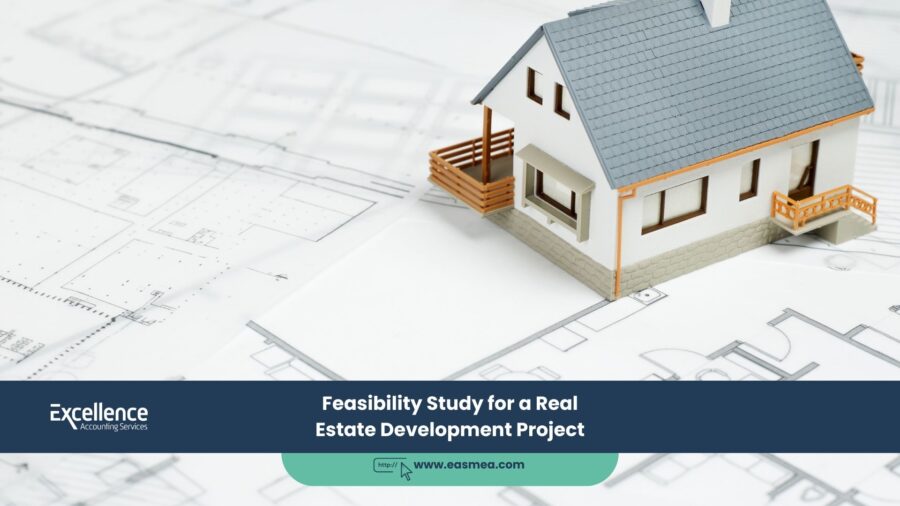A Guide to Feasibility Studies for Real Estate Development Projects in the UAE
The iconic skyline of the UAE is a testament to the ambition and vision of its real estate developers. From towering skyscrapers to sprawling master communities, development projects are a primary engine of the nation’s growth. However, for every successful project that graces the skyline, countless others never break ground, collapsing under the weight of poor planning, flawed financial models, or unforeseen regulatory hurdles. The difference between success and failure almost always comes down to the quality of the initial planning—and the cornerstone of that planning is the **feasibility study**.
- A Guide to Feasibility Studies for Real Estate Development Projects in the UAE
- Why a Feasibility Study is the First Step in Development
- The Core Components of a Real Estate Feasibility Study
- Building a Bankable Case with Excellence Accounting Services (EAS)
- Frequently Asked Questions (FAQs)
- Planning a Real Estate Development?
A feasibility study for a real estate development is a comprehensive, data-driven analysis that determines the viability of a project. It is a critical, investigative process that must be completed before any significant capital is committed to land acquisition or construction. It is the blueprint that tests the project’s viability against the realities of the market, the complexities of the law, the constraints of the physical site, and the rigorous demands of financial lenders and investors.
This guide provides a detailed framework for conducting a feasibility study for a real estate development project in the UAE. We will break down the essential components that every developer and investor must analyze to mitigate risk and build a foundation for a profitable venture.
Key Takeaways
- A Prerequisite for Funding: A professional feasibility study is a non-negotiable requirement for securing financing from banks or attracting equity investors for any real estate project in the UAE.
- “Highest and Best Use”: A key objective of the market analysis is to determine the “highest and best use” of the land—the type of development (e.g., residential, commercial, mixed-use) that will generate the highest return.
- Navigating the Authorities: Legal and regulatory feasibility, including securing approvals from the Dubai Land Department (DLD), RERA, and the relevant municipality, is a critical and complex hurdle.
- Financial Model is Key: The financial feasibility study is the heart of the report, detailing everything from land and construction costs to projected sales/leasing revenues and key investment metrics like IRR and NPV.
- It’s a Risk Management Tool: The ultimate purpose of the study is to identify and quantify all potential risks, allowing the developer to make an informed “Go/No-Go” decision. A professional feasibility study is your primary defense against a bad investment.
Why a Feasibility Study is the First Step in Development
Real estate development is exceptionally capital-intensive. The financial commitment is enormous, and the timeline from concept to completion can span several years. A feasibility study is the process that justifies this commitment.
- It Validates the Vision: It tests the developer’s initial vision against hard market data and financial realities.
- It Uncovers Hidden Roadblocks: It identifies potential deal-breakers early, such as zoning restrictions or unforeseen site preparation costs, before millions are spent on land.
- It Forms the Basis of the Business Plan: The data and conclusions from the feasibility study are used to create the detailed business plan and financial projections needed to run the project.
- It Builds Investor Confidence: A thorough, independent study shows investors that the project is well-researched and that the developer is a prudent manager of capital.
A developer’s vision builds the dream. A feasibility study builds the case. You cannot secure funding without both.
The Core Components of a Real Estate Feasibility Study
A comprehensive study for a development project is a multi-disciplinary effort, typically involving market analysts, architects, engineers, legal advisors, and financial consultants.
1. Market Feasibility Analysis
This section assesses the demand for the proposed project and its position in the competitive landscape.
- Location and Site Analysis: A deep dive into the chosen location, assessing its connectivity, visibility, proximity to amenities, and the surrounding environment.
- Demographic and Economic Analysis: Studying the population trends, income levels, and economic drivers of the area to understand the target market.
- Supply and Demand Analysis: Analyzing the existing supply of similar properties (the competition) and the current and projected demand for the proposed type of development.
- “Highest and Best Use” Study: This is a critical output. Based on all the market data, this analysis determines the optimal type, size, and quality of development for the site to maximize its potential value.
2. Legal and Regulatory Feasibility
This ensures the project is legally permissible and navigates the complex web of UAE regulations.
- Land Title and Ownership Verification: A thorough legal check with the DLD to confirm clear and unencumbered title to the land.
- Zoning and Land Use Regulations: Confirming that the proposed development complies with the zoning regulations and master plan for the area, including rules on building height, density (Floor Area Ratio), and setbacks.
- Permits and Approvals: Outlining the entire roadmap of required approvals from all relevant authorities, including the Municipality, RERA, DEWA, and the RTA.
- Master Developer Covenants: If the land is within a master community (e.g., Emaar or Dubai Properties), the study must review and ensure compliance with the master developer’s specific design and use regulations.
3. Technical and Design Feasibility
This assesses the physical and engineering aspects of the project.
- Site Analysis: Includes geotechnical surveys (to assess soil conditions), topographical surveys, and an assessment of existing utility connections.
- Conceptual Design and Massing: Developing preliminary architectural designs and site plans to determine the project’s scale and layout.
- Construction Cost Estimation: Working with quantity surveyors to develop a detailed budget for all hard and soft construction costs.
- Infrastructure Assessment: Ensuring the existing infrastructure (roads, power, water) can support the new development.
4. Financial Feasibility
This is the ultimate test of the project’s viability, where all the data is synthesized into a financial model.
- Total Project Cost: A comprehensive budget including land acquisition cost, hard costs (construction), soft costs (design, licensing, marketing), and financing costs.
- Financing Plan: The proposed capital stack, detailing the mix of developer equity and bank debt.
- Revenue Projections: Detailed forecasts of revenue from either the sale of units (for a “build-to-sell” project) or rental income (for a “build-to-hold” project).
- Investment Analysis: Calculating the key financial metrics that investors and banks will scrutinize, including:
- Net Present Value (NPV)
- Internal Rate of Return (IRR)
- Return on Investment (ROI) and Return on Equity (ROE)
Building a Bankable Case with Excellence Accounting Services (EAS)
The financial feasibility model is the heart of any development study. At EAS, we specialize in providing the rigorous financial analysis that turns a development vision into a bankable project.
- Investor-Grade Feasibility Studies: We lead the development of comprehensive feasibility studies, with a special focus on creating robust and defensible financial models.
- Expert Financial Modeling: Our CFO services team builds sophisticated, multi-year financial projections that model all costs, revenues, and financing to calculate key investment returns (IRR, NPV, ROI).
- Business Plan and Fundraising Support: We translate the feasibility study into a compelling business plan and financial package designed to secure debt financing from banks and equity from investors.
- Transaction Advisory: Our business consultancy team can provide strategic advice on project structuring, financing, and compliance.
Frequently Asked Questions (FAQs)
An appraisal or valuation determines the current market value of an *existing* property or a piece of land as-is. A feasibility study is a forward-looking analysis that determines the viability and potential value of a *proposed future development* on that land.
For off-plan sales in Dubai, developers are legally required to open a RERA-approved escrow account. All payments from buyers must be deposited into this account, and funds can only be withdrawn for project-specific costs, linked to construction milestones. The feasibility study must factor in the compliance and management of this account.
This is a key part of the market analysis. It involves studying the sales performance of comparable off-plan launches in the area, analyzing overall market sentiment, and factoring in the developer’s brand reputation and the project’s marketing plan.
Hard costs are the tangible construction costs, such as concrete, steel, and labor. Soft costs are the intangible project costs, such as architectural and engineering fees, legal fees, permits, marketing, and financing costs.
While you can do preliminary research, a formal feasibility study that will be accepted by a bank or major investor must be conducted by a team of qualified, independent professionals. Its credibility hinges on its objectivity.
A good financial model will include sensitivity and scenario analysis. It will model different scenarios—a base case, an optimistic case, and a pessimistic case (e.g., with lower sales prices or a slower sales velocity)—to assess the project’s resilience to market fluctuations.
This is a key zoning regulation that determines the total amount of buildable area allowed on a piece of land. It’s a ratio of the total building floor area to the size of the land plot. The maximum permissible GFA is a critical input for the entire study.
The land acquisition cost is the primary initial cash outflow in the financial model. The analysis will determine if the projected profits from the development are sufficient to provide an attractive return on the land investment.
This is a successful result. The study has saved you from a potentially catastrophic financial loss. The findings should be analyzed to see if the project can be made viable by changing its scope, design, or target market, or if the land’s “highest and best use” is something different entirely.
The cost is a small percentage of the total project value but can be a significant number, varying based on the project’s scale and complexity. It is an essential, non-negotiable investment in risk management.
Conclusion: Your Blueprint for a Profitable Development
In the high-stakes world of UAE real estate development, a feasibility study is not a preliminary step to be rushed; it is the entire foundation upon which a successful project is built. It is the disciplined process that provides the critical data needed to transform a plot of land into a profitable asset, navigating the complex interplay of market forces, regulatory hurdles, and financial realities. It is, quite simply, the blueprint for success.
Planning a Real Estate Development?
Partner with Excellence Accounting Services to conduct a comprehensive, bank-ready feasibility study for your UAE real estate venture.




